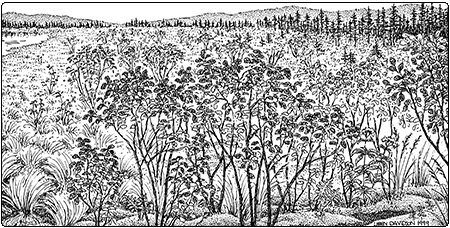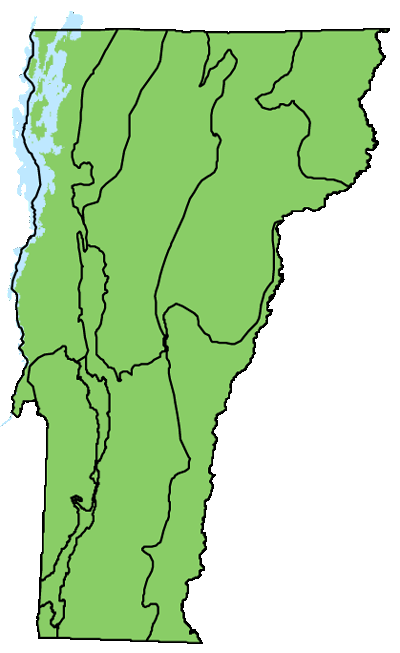Ecology and Physical Setting 
Before walking into an Alder Swamp, be sure someone knows where you are going—it’s easy to get turned around in the tangle of alders. A better way to experience an Alder Swamp is to paddle a canoe along a slowly-moving, sinuous stream passing through it. In spring you might see willows and alders coming into flower and hear the songs of yellow warblers. Mink and moose can be observed any time of year.
This is our most common shrub-dominated wetland. Alder Swamps vary in size from less than one acre to over 100 acres. They occur in a variety of physical settings, including the margins of lakes and ponds, poorly drained depressions and basins, and in the backwater floodplains of rivers and streams. The soils of Alder Swamps are generally saturated throughout the growing season and experience some degree of seasonal flooding. In some situations, the majority of the woody vegetation grows on drier hummocks above permanent standing water. The soils vary from mineral soils with a high organic content in the driest swamps to deep organic muck or peat in some of the wettest swamps.

Alder Swamps commonly occur in association with other wetland types, including Alluvial Shrub Swamps, Sedge Meadows, and marshes. Alder Swamps can also occur in narrow, wet lagg zones adjacent to peatlands.
Alder Swamps are often parts of beaver-created wetlands, but these examples may not persist over time. In these dynamic systems, the distribution of natural communities changes with the cycle of beaver colonization and abandonment, and Alder Swamps can come and go. Alder can be an early successional species in human-disturbed wetlands, such as those cleared for agriculture. These places can mimic Alder Swamps, but they may eventually succeed to other wetland communities.
Vegetation
In most Alder Swamps, speckled alder is the dominant tall shrub, often forming dense, nearly impenetrable thickets. Other common shrubs that may be present in varying amounts include shrub willows, dogwoods, wild raisin, arrowwood, and sapling red maple. In warmer regions of Vermont, other shrubs including highbush blueberry, spicebush, and poison sumac may be abundant. Alder Swamps that receive calcareous groundwater enrichment may have alder-leaved buckthorn, shrubby cinquefoil, and red-osier dogwood.
Common herbs in Alder Swamps are variable, but a few ubiquitous species include tussock sedge, bluejoint grass, bristly sedge, Canada mannagrass, fowl mannagrass, purple-stemmed aster, cinnamon fern, sensitive fern, and Joe-pye weed.
Wildlife Habitat
Alder Swamps provide the largest area of naturally occurring shrub-dominated habitat in Vermont. These swamps are important breeding habitat for many species of migratory birds, including alder flycatcher, yellow warbler, common yellowthroat, swamp sparrow, northern waterthrush, gray catbird, and the rare blue-winged warbler. American woodcocks feed on the abundant worms and other invertebrates found in the moist soils of Alder Swamps. Gray treefrogs may be abundant in Alder Swamps. These small frogs breed in temporary or permanent shallow water and climb trees and shrubs to make their trilling calls.
The harvester is one of the few primarily carnivorous butterflies in North America. The orange-brown adult butterflies feed on the honeydew produced by woolly alder aphids. The females lay their eggs among aphid colonies and when the larvae hatch, they feed on the aphids. A macropis bee, Macropis nuda, specializes in feeding on the pollen and floral oils of the genus Lysimachia—swamp candles are a member of this genus and are common in Alder Swamps.
Variants
- Alder Peatland is found in cooler, primarily northern areas of the state and has deep, acidic peat accumulation. In addition to alder, characteristic species include mountain holly, black spruce, Labrador tea, rhodora, sheep laurel, blue flag, water arum, three-seeded sedge, hoary sedge, boreal bog sedge, and sphagnum mosses.
Related Communities
- Alluvial Shrub Swamp is also dominated by speckled alder but has mineral alluvial soils and floodplain species such as ostrich fern, wild ryes, wild cucumber, and virgin’s bower.
Conservation Status and Management Considerations
Alder Swamps are a common but sometimes underappreciated community type in Vermont. As a result, very little inventory has been conducted. Several
good examples are found on conserved lands, but additional examples should be identified and protected.
Distribution/Abundance 
This common community occurs throughout Vermont and eastern North America.
Characteristic Plants
Shrubs
Abundant Species
Speckled alder – Alnus incana
Occasional to Locally Abundant Species
Common pussy willow – Salix discolor
Silky willow – Salix sericea
Bebb’s willow – Salix bebbiana
Woolly-headed willow – Salix eriocephala
Red-osier dogwood – Cornus sericea
Silky dogwood – Cornus amomum
Wild raisin – Viburnum nudum var. cassinoides
Red maple – Acer rubrum
Arrowwood – Viburnum dentatum
Smooth alder – Alnus serrulata
Poison sumac – Toxicodendron vernix
Characteristic of Alder Peatland Variant
Mountain holly – Ilex mucronata
Sheep laurel – Kalmia angustifolia
Labrador tea – Rhododendron groenlandicum
Rhodora – Rhododendron canadense
Black spruce – Picea mariana
Herbs
Occasional to Locally Abundant Species
Tussock sedge – Carex stricta
Bluejoint grass – Calamagrostis canadensis
Bristly sedge – Carex comosa
Canada mannagrass – Glyceria canadensis
Fowl mannagrass – Glyceria striata
Purple-stemmed aster – Symphyotrichum puniceum
Cinnamon fern – Osmundastrum cinnamomeum
Sensitive fern – Onoclea sensibilis
Joe-pye weed – Eutrochium maculatum
Three-seeded sedge – Carex trisperma
Hoary sedge – Carex canescens
Boreal bog sedge – Carex magellanica
Characteristic of Alder Peatland Variant
Blue flag – Iris versicolor
Water arum – Calla palustris
Marsh St. John’s-wort – Triadenum fraseri
Swamp candles – Lysimachia terrestris
Three-leaved false Solomon’s seal – Maianthemum trifolium
Bryophytes
Moss – Sphagnum fallax
Moss – Sphagnum angustifolium
Moss – Sphagnum magellanicum
Rare and Uncommon Plants
Shining rose – Rosa nitida
Satiny willow – Salix pellita
Associated Animals
Gray treefrog – Hyla versicolor
Star-nosed mole – Condylura cristata
Meadow vole – Microtus pennsylvanicus
American beaver – Castor canadensis
Ruffed grouse – Bonasa umbellus
American woodcock – Scolopax minor
Alder flycatcher – Empidonax alnorum
Yellow warbler – Setophaga petechia
Common yellowthroat – Geothlypis trichas
American redstart – Setophaga ruticilla
Northern waterthrush – Parkesia noveboracensis
Chestnut-sided warbler – Setophaga pensylvanica
Swamp sparrow – Melospiza georgiana
Gray catbird – Dumetella carolinensis
Harvester – Feniseca tarquinius
Macropis bee – Macropis nuda
Woolly alder aphid – Prociphilus tessallatus
Rare and Uncommon Animals
Water shrew – Sorex palustris
Blue-winged warbler – Vermivora cyanoptera
Places to Visit
Halfmoon Cove Wildlife Management Area, Colchester, Vermont Fish and Wildlife Department (VFWD)
Wenlock Wildlife Management Area, Ferdinand, VFWD
Victory Basin Wildlife Management Area, Victory, VFWD
Shelburne Pond Natural Area, Shelburne, University of Vermont and The Nature Conservancy
Nulhegan Basin, Silvio O. Conte National Fish and Wildlife Refuge, Lewis, U.S. Fish and Wildlife Service
